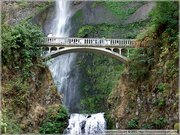Canyon
|
|
A canyon, or gorge, is a valley walled by cliffs. Most canyons originate by a process of long-time erosion from a plateau level, with a stream gradually carving out its valley. The cliffs form because harder rock strata that are resistant to erosion and weathering remain exposed on the valley walls. Canyons are much more common in arid areas than in wetter areas because weathering has a lesser effect in arid zones. Canyons' walls are often formed of resistant sandstones or granite. Submarine canyons are those which form underwater, generally at the mouths of rivers.
The word Canyon is generally used in the United States, while the word Gorge is more common in Europe and Australasia, though it is also used in some parts of the United States and Canada.
In the southwestern United States, canyons are important archeologically because of the many cliff-dwellings built there, largely by the Ancient Pueblo Peoples.
Sometimes large rivers run through canyons as the result of gradual geologic uplift. These are called entrenched rivers, because they are unable to easily alter course. The Colorado River and the Snake River in the northwestern United States are two examples of this.
Canyons often form in areas of limestone rock. Limestone is to a certain extent soluble, so cave systems form in the rock. When these collapse a canyon is left, for example in the Mendip Hills in Somerset and Yorkshire Moors in Yorkshire, England.
Two canyons usually attributed as the world's largest are the:
- Grand Canyon in Arizona, USA, and the
- Copper Canyon in Chihuahua, Mexico
However, this definition used are rather inprecise, as a canyon can be "large" by its depth, length, or the total area of the canyon system. Also the inaccessibility of the major canyons in the Himalaya contributes to the fact that they are not often known or regarded as candidates for the biggest canyon. The deepest canyon in the world, Yarlung Tsangpo Canyon, along the Brahmaputra in Tibet, China even slightly longer than Grand Canyon, is also regarded by many as be the world's largest canyon, followed by the Kali Gandaki Canyon in Nepal, and Polung Tsangpo Canyon in Tibet.
Other well-known canyon systems include:
- Avon Gorge in Bristol, England
- Tara River Canyon in Montenegro
- Canyon Fortaleza in Cambarᠤo Sul, Brazil
- Cataract Gorge in Launceston, Australia
- Cheddar Gorge in Somerset, England
- Colca Canyon along the Colca River in Peru
- Fish River Canyon in Namibia
- Hells Canyon in Idaho and Oregon, USA
- Ironbridge Gorge in Shropshire, England
- Itaimbezinho in Cambarᠤo Sul, Brazil
- Malacara in Praia Grande, Brazil
- Palo Duro Canyon in Texas, USA
- Red River Gorge in Kentucky, USA
- Royal Gorge in Colorado, USA
- Three Gorges in China
- Kings Canyon in California, USA
Other lesser-known canyon systems include:
Other canyons in the Himalayas include:
The Blue Mountains west of Sydney in New South Wales, Australia contain many canyons carved into the sandstone rock.


